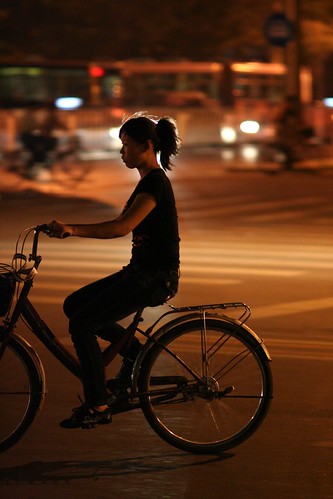China -today the nation with the largest fleet of bicycles in the
world- is surprisingly underrepresented in cycle history: we know nearly
nothing about Chinese cycle history, cycle production, cycling habits
or other aspects of the bicycle in China.
This contribution presents first results from historical
Chinese sources, which were collected for my doctoral thesis, on China's
cycle history around the turn of the century (1880s to 1920s). The
article intends to give a chronological overview of the introduction and
spread of the bicycle in China, from the first written account, to the
founding of the People's Republic of China in 1949. It takes up the
question of how Chinese contemporaries of the late 19th and early 20th
century perceived the bicycle, as a technically new and culturally
foreign means of transportation. The paper illustrates the process of
cultural appropriation in the changing terminology for the bicycle.
A chronology of Chinese cycle history
1860s. The earliest Chinese reports and official perception of the bicycle
Shortly after Michaux' construction of the pedal-driven
prototype of a bicycle, and even some months before the invention became
known to the European public, a selected Chinese readership learned of a
new "cycling device" from the travel notes of a Chinese official. The
author, Binchun, had just returned from his journey to Western Europe.
As member of the first group of high-ranking Chinese officials, he had
visited France, Great Britain, Germany and other nations between March
and July 1866. After his return, he reported to the court on various
curiosities he had discovered during his mission in the West. Among
these he had seen in Paris two types of a strange device:
"On the avenues", Binchun writes, "people ride on a vehicle
with only two wheels, which is held together by a pipe. They sit above
this pipe and push forward with movements of their feet, thus keeping
the vehicle moving. There's yet another kind of construction which is
propelled by foot pedaling. They dash along like galloping horses."
(Binchun, Chengcha Biji, 1866/68)
Binchun's delegation was formally sent on a diplomatic mission,
but the participants had been instructed by the Chinese imperial court
to investigate the latest trends in industrial development,
administrative structure, and military technology. They were therefore
very aware of all kinds of technical constructions. But while other
technological discoveries of their visits -especially the steam engine
and its mobile sister, the railway- are reported on in depth, and
critically considered by the court officials with a view to their
practical application towards the modernization of China's economy, the
velocipede is not commented on in any known official source.
To assess the degree to which the introduction of modern
technological products challenged Chinese society at the end of the 19th
century and later, one has to take into account the need for
industrialization and modernization in China. Military defeats and
treaties after the 1840s triggered this, the Chinese saw them as
humiliations, and they were closely connected to a sinking self-esteem.

more about urban China:
No comments:
Post a Comment